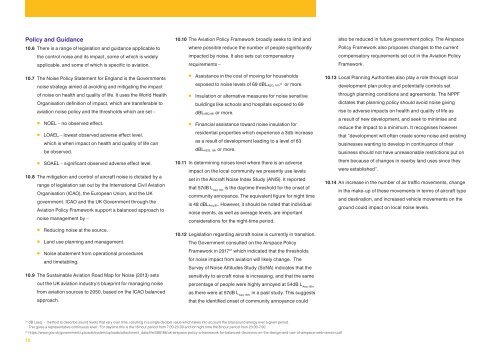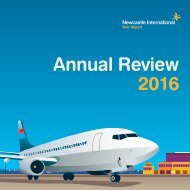Airport Masterplan 2035 LOW RES
Create successful ePaper yourself
Turn your PDF publications into a flip-book with our unique Google optimized e-Paper software.
<strong>Masterplan</strong> <strong>2035</strong><br />
Policy and Guidance<br />
10.10 The Aviation Policy Framework broadly seeks to limit and<br />
also be reduced in future government policy. The Airspace<br />
Aircraft ‘Air’ Noise<br />
10.19 The contour footprints have been assessed against<br />
The potential extension of the runway would result in a<br />
10.6 There is a range of legislation and guidance applicable to<br />
where possible reduce the number of people significantly<br />
Policy Framework also proposes changes to the current<br />
10.15 Aircraft noise describes the noise produced by an aircraft<br />
households and population contained within each<br />
different pattern of exposure owing to the changing nature<br />
the control noise and its impact, some of which is widely<br />
impacted by noise. It also sets out compensatory<br />
compensatory requirements set out in the Aviation Policy<br />
during flight, preparing for departure and decelerating<br />
contour. They indicate that the potential increase in airport<br />
of aircraft operations, which we have modelled from<br />
applicable, and some of which is specific to aviation.<br />
requirements –<br />
Framework.<br />
following landing.<br />
operations could result in a larger population being<br />
2030-<strong>2035</strong>.<br />
10.7 The Noise Policy Statement for England is the Governments<br />
noise strategy aimed at avoiding and mitigating the impact<br />
of noise on health and quality of life. It uses the World Health<br />
Organisation definition of impact, which are transferable to<br />
aviation noise policy and the thresholds which are set –<br />
l NOEL – no observed effect.<br />
l LOAEL – lowest observed adverse effect level,<br />
which is when impact on health and quality of life can<br />
be observed.<br />
l SOAEL – significant observed adverse effect level.<br />
10.8 The mitigation and control of aircraft noise is dictated by a<br />
range of legislation set out by the International Civil Aviation<br />
Organisation (ICAO), the European Union, and the UK<br />
government. ICAO and the UK Government through the<br />
Aviation Policy Framework support a balanced approach to<br />
noise management by –<br />
l Reducing noise at the source.<br />
l Land use planning and management.<br />
l Noise abatement from operational procedures<br />
and timetabling.<br />
10.9 The Sustainable Aviation Road Map for Noise (2013) sets<br />
out the UK aviation industry’s blueprint for managing noise<br />
from aviation sources to 2050, based on the ICAO balanced<br />
approach.<br />
l Assistance in the cost of moving for households<br />
30<br />
exposed to noise levels of 69 dBL AEQ, 16h or more.<br />
l Insulation or alternative measures for noise sensitive<br />
buildings like schools and hospitals exposed to 69<br />
dBL AEQ, 16h or more.<br />
l Financial assistance toward noise insulation for<br />
residential properties which experience a 3db increase<br />
as a result of development leading to a level of 63<br />
dBL AEQ, 16h or more.<br />
10.11 In determining noises level where there is an adverse<br />
impact on the local community we presently use levels<br />
set in the Aircraft Noise Index Study (ANIS). It reported<br />
that 57dB L Aeq 16h<br />
is the daytime threshold for the onset of<br />
community annoyance. The equivalent figure for night time<br />
is 48 dBL Aeq,8h. However, it should be noted that individual<br />
noise events, as well as average levels, are important<br />
considerations for the night-time period.<br />
10.12 Legislation regarding aircraft noise is currently in transition.<br />
The Government consulted on the Airspace Policy<br />
Framework in 2017 31 which indicated that the thresholds<br />
for noise impact from aviation will likely change. The<br />
Survey of Noise Attitudes Study (SoNA) indicates that the<br />
sensitivity to aircraft noise is increasing, and that the same<br />
percentage of people were highly annoyed at 54dB L Aeq 16hr<br />
as there were at 57dB L Aeq 16hr<br />
in a past study. This suggests<br />
that the identified onset of community annoyance could<br />
30<br />
dB <br />
Laeq - method to describe sound levels that vary over time, resulting in a single decibel value which takes into account the total sound energy over a given period.<br />
This gives a representative continuous level. For daytime this is the 16 hour period from 7 00-23.00 and for night time the 8 hour period from 23.00-7.00.<br />
31<br />
https://www.gov.uk/government/uploads/system/uploads/attachment_data/file/588186/uk-airspace-policy-a-framework-for-balanced-decisions-on-the-design-and-use-of-airspace-web-version.pdf<br />
10.13 Local Planning Authorities also play a role through local<br />
development plan policy and potentially controls set<br />
through planning conditions and agreements. The NPPF<br />
dictates that planning policy should avoid noise giving<br />
rise to adverse impacts on health and quality of life as<br />
a result of new development, and seek to minimise and<br />
reduce the impact to a minimum. It recognises however<br />
that “development will often create some noise and existing<br />
businesses wanting to develop in continuance of their<br />
business should not have unreasonable restrictions put on<br />
them because of changes in nearby land uses since they<br />
were established”.<br />
10.14 An increase in the number of air traffic movements, change<br />
in the make-up of these movements in terms of aircraft type<br />
and destination, and increased vehicle movements on the<br />
ground could impact on local noise levels.<br />
10.16 In order to assess the current and future noise impacts, a<br />
noise contour modelling exercise was undertaken by the<br />
Environmental Research and Consultancy Department<br />
(ERCD) of the Civil Aviation Authority (CAA), using the<br />
internationally recognised ANCON-II noise model. The<br />
modelling is based on forecast future flight schedules<br />
and so takes account of the forecast number and types of<br />
aircraft, destinations, and flight paths based on our noise<br />
and monitoring tracking system. Noise contour maps were<br />
produced for each review year of the <strong>Masterplan</strong>, as shown<br />
in Appendix 2.<br />
10.17 Noise contours provide an indication of the average noise<br />
exposure within a particular area around the <strong>Airport</strong>.<br />
Levels for the day-time contours start at 54 dB L Aeq 16h and<br />
the night-time contours at 48 dBL Aeq 8h increasing in 3dB<br />
steps to 72dB L Aeq 16h and 66 dB L Aeq 8h respectively.<br />
10.18 If changes to Government policy in relation to the onset<br />
of community annoyance from aviation noise are adopted,<br />
we will review the impact of current and potential future<br />
operations. Whilst contours and indicator noise thresholds<br />
provide valuable and robust information, we appreciate that<br />
noise is subjective and populations not contained within<br />
the identified metrics might hear the <strong>Airport</strong>’s operations.<br />
We will continue to work cooperatively with communities,<br />
the local planning authority, and developers close to the<br />
contours to understand noise exposure levels and respond<br />
to all complaints.<br />
exposed to aircraft noise in terms of the 54 dBL Aeq 16h<br />
and 63 dBL Aeq 16h contours during the day and the<br />
48 dBL Aeq 8h<br />
, and 54 dBL Aeq 8h<br />
at night,.<br />
This is shown in Table 5.<br />
Table 5 – Estimated Increase in Population Exposed to Noise Over the <strong>Masterplan</strong> Period With<br />
and Without a Runway Extension for Potential Future Peak Day Operations<br />
Period<br />
Day<br />
Night<br />
Noise Level<br />
Population<br />
within<br />
54 dBLAeq<br />
16h contour<br />
Population<br />
within<br />
63 dBLAeq 16h<br />
contour<br />
Population<br />
within<br />
48 dBL Aeq<br />
8h contour<br />
Population<br />
within<br />
54 dBL Aeq<br />
8h contour<br />
2016<br />
population<br />
baseline<br />
Without extended runway<br />
(<strong>2035</strong>)<br />
Estimated<br />
population<br />
within noise<br />
contour<br />
Increase over<br />
2016 baseline<br />
With extended runway<br />
(<strong>2035</strong>)<br />
Estimated<br />
population<br />
within noise<br />
contour<br />
Increase over<br />
2016 baseline<br />
3,650 8,050 4,400 8,950 5,300<br />
0




